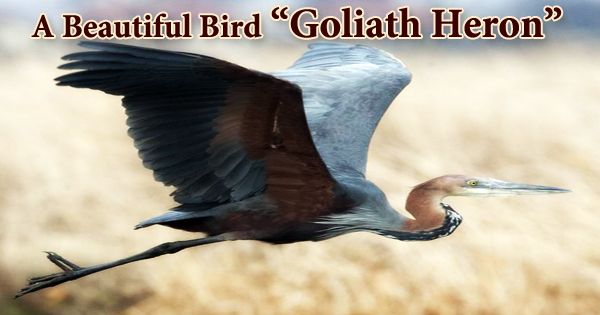The Goliath heron (Ardea goliath), also known as the giant heron, is a nocturnal bird that can be seen feeding in wetlands alone or in pairs at dusk. Its movements tend to be sluggish and ponderous. It is a large wading bird in the Ardeidae family that can be found in Sub-Saharan Africa and Southwest and South Asia in smaller numbers. The Goliath Heron is a timid creature. It’s a sedentary activity. Although there are no known courtship displays, this species is monogamous. Before the breeding season, which begins with the rainy season, their long feathers on the crest, collar, breast, and back grow. The world’s largest heron can be found here. Standing height averages over 1.4 meters (4.5 feet), with a wingspan of at least 7 feet (2 meters) and a weight of about 4 kilograms (9 lb). Its flight is sluggish and ponderous, and its legs are not kept horizontally like those of other herons. The tarsus is between 21.2 and 25.5 cm (8.3 and 10.0 in) long, and the wing chord is about 60.7 cm (23.9 in) long, according to normal measurements. The culmen is 18 to 20 cm (7.1 to 7.9 in) long, and the bill from the gape is about 24 cm long (9.4 in). The male and female have a similar appearance, with slate gray and chestnut feathers covering their bodies. The chestnut color is found on the head and its bushy crest, as well as the face, back, and sides of the body. White streaks run across the chin, throat, foreneck, and upper breast, with black streaks running through the foreneck and upper breast. Buff with black stripes on the lower breast and abdomen. The upper beak is black, and the lores (areas on the side of a bird’s head between the eyes and bill) and orbital areas are yellow with a greenish tinge. The legs and feet are black, and the eyes are yellow. Goliath Heron makes noises that sound like an old dog barking. Croaks, squawks, growls, and gurgles are among the calls. Outside of the breeding season, they are always deafeningly quiet. The only heron with plumage that is very similar to the Goliath’s, the widespread purple heron, is much smaller. Despite having plumage features in common with purple birds, the Goliath’s nearest living relatives are the great-billed and white-bellied herons of Southern Asia. This species group is known as the “giant herons” because of their enormous size.

Goliath Heron can be found in a variety of habitats, including forests, streams, marshes, mangroves, and river deltas. It needs freshwater, but it can be found in both salt and fresh waters on coastal islands. They’ve been as far as 2,100 meters above sea level (6,900 ft). They prefer pristine wetlands and usually avoid areas where human disturbances occur frequently. The Goliath heron is a fish-eating heron that can capture and consume fairly large fish. Frogs, small rodents, and snakes are also eaten by this heron. The prey is fully swallowed. When large fish are present, the Goliath heron will stab them in the gill area with its beak, stun them, and then take them to the bank to feed. The Goliath heron is prone to kleptoparasitism, with fish eagles frequently stealing their catch. The Goliath Heron can be found in Sub-Saharan Africa, as well as small populations in the southwest and south Asia, Pakistan, Syria, and Iraq. It is both a resident and a dispersive species. Normally, this bird breeds alone, but it does sometimes breed in a mixed heron colony. The couple constructs a huge stick nest, which can be found in trees, reedbeds, or on the ground on an island. The nest is constructed right next to a body of water. The female lays two to three eggs, and the incubation period is about four weeks. Both parents take turns incubating and feeding the chicks. Around 6 weeks after hatching, the chicks fledge. The nests are wide but flimsy, measuring from 1 to 1.5 m (3.3 to 4.9 ft) in diameter (depending on available vegetation around the nesting site). Eggs are light blue and weigh about 108 g. They measure 72 by 54 mm (2.8 by 2.1 in) and are 72 by 54 mm (2.8 by 2.1 in) in size (3.8 oz). The clutch size ranges from two to five (usually 3 or 4). The incubation period is 24 to 30 days. The Goliath Heron is a solitary hunter. They can remain motionless for up to an hour, adopting a tall pose to improve their visual acuity. Prey fights back ferociously. To shock the fish, Goliath Heron stabs it in the gill area. It which loses its prey at this time due to harassment from other fish predators. Only African Fish Eagles (Haliaeetus vocifer) will steal fish from the Goliath Heron. The full-grown Goliath heron does not have any frequent avian predators due to its size and intimidating bill. Because of its size, the Goliath Heron has less competition for food than other heron species. Wading into deeper water than other animals, it hunts. The regional populations of this species are small. Pesticide use can pose a threat to them.
















